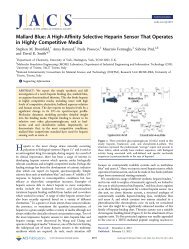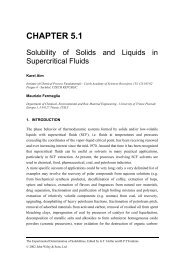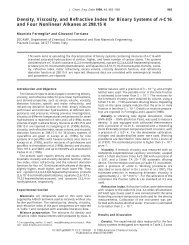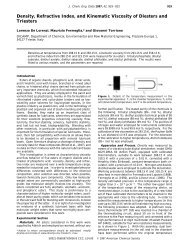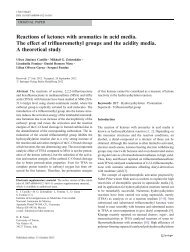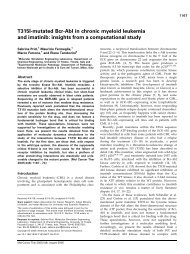Hydrogen sulphide removal from biogas by zeolite ... - Mose
Hydrogen sulphide removal from biogas by zeolite ... - Mose
Hydrogen sulphide removal from biogas by zeolite ... - Mose
You also want an ePaper? Increase the reach of your titles
YUMPU automatically turns print PDFs into web optimized ePapers that Google loves.
P. Cosoli et al. / Chemical Engineering Journal 145 (2008) 86–92 91in E values. Accordingly, sorption site interchange is more difficultin the MFI apolar framework. To consider more details of adsorptionselectivity, we mapped H 2 S selectivity with respect to CH 4 and CO 2in Fig. 5.Selectivity factors are generally very high in hydrophilic <strong>zeolite</strong>s;again, according to our simulations, the best results are achievedwith NaY. To find a rationale for these selectivity curves is lessstraightforward. As a general observation, they tend to decreasequickly for NaY and LTA; accordingly, selectivity is generally higherat low H 2 S partial pressures, which indicates that sorption selectivitymechanism seems to work better in the typical low rangeof <strong>biogas</strong> H 2 S content. Lower selectivity for NaY and LTA may beexplained <strong>by</strong> the fact that, when P H2 S increases, H 2 S gains newadsorption sites, for which H 2 S is favored over CH 4 and CO 2 , butnot as well as for old adsorption sites, at lower P H2 S. Selectivityfor NaX shows less variation, probably because selectivity valuesat low H 2 S pressures are already quite low. This, in turn, could bedue to the higher steric hindrance exerted <strong>by</strong> the higher numberof cations characterizing this framework. Once again, MFI does notshow selectivity for H 2 S.We also investigated the density fields in the pores of the <strong>zeolite</strong>3D periodic structures (Fig. 6). Although for low P H2 S in somecases, distributions are not symmetrical, it is qualitatively evidenthow H 2 S prevalently substitutes CH 4 in sorption sites (especially inlarger pores). Zeolites NaX and LTA show similar behaviors, whileMFI adsorption site substitutions are much less evident, if at all.4. ConclusionsThe main results of this work confirm that hydrophilic <strong>zeolite</strong>sare more indicated for H 2 S adsorption. Differences arise, asevidences <strong>by</strong> both pure H 2 S and <strong>biogas</strong> mixture adsorption simulations,<strong>from</strong> adsorption site competition.Adsorption isotherms, isosteric heats of adsorption and energydistributions confirm specific trends and explain adsorption behaviors.Results are of remarkable practical use if considered in termsof selectivity, according to which a ranking for the considered<strong>zeolite</strong>s towards H 2 S can be formulated: the FAU NaY frameworkappears the best choice, being favored over NaX, which has essentiallythe same structure but a different Si/Al ratio, ultimatelyresulting in more sterical hindered pores. In this way, a reasonableranking for the best <strong>zeolite</strong> choice has been determined. Itshould be noticed that for some kinds of <strong>zeolite</strong>s, as LTA or MFI,H 2 S is scarcely adsorbed when mixture are considered, this affectsthe shape of adsorption isotherms and, probably, the accuracy ofMonte Carlo sampling. In these cases, further analysis may beperformed to obtain much quantitative results. This can be obviouslydone <strong>by</strong> speeding up calculations or applying new, moreefficient sampling methods, which is out of the scope of the presentwork.AcknowledgementWe like to acknowledge Dr. Roberto Millini for the helpful discussionsand support.Appendix A. Supplementary dataSupplementary data associated with this article can be found,in the online version, at doi:10.1016/j.cej.2008.07.034.References[1] U. Marchaim, Biogas Technology as an Environmental Solution to Pollution,Bull. FAO Agric. Services, Rome, Italy, 1992.[2] R.E. Speece, Anaerobic Biotechnology for Industrial Wastewaters, Archae Press,Nashville, Tennessee, USA, 1996.[3] G. Lettinga, A.F.M. van Velsen, S.W. Hobma, W. de Zeeuw, A. Klapwijk, Useof the upflow sludge blanket (USB) reactor concept for biological wastewatertreatment, especially for anaerobic treatment, Biotech. Bioeng. 22 (1980)699–734.[4] A. van Haandel, M.T. Kato, P.F.F. Cavalcanti, L. Florencio, Anaerobic reactordesign concepts for the treatment of domestic wastewater, Rev. Environ. Sci.Biol./Technol. 5 (2006) 21–38.[5] K. Braber, Anaerobic digestion of municipal solid waste: a modern wastedisposal option on the verge of breakthrough, Biomass Bioenergy 9 (1995)365–376.[6] V.N. Gunaseelan, Anaerobic digestion of biomass for methane production: areview, Biomass Bioenergy 13 (1997) 83–114.[7] T.H. Mil<strong>by</strong>, R.C. Baselt, <strong>Hydrogen</strong> sulfide poisoning: clarification of some controversialissues, Am. J. Ind. Med. 35 (1999) 192–195.[8] S. Nishimura, M. Yoda, Removal of hydrogen <strong>sulphide</strong> <strong>from</strong> ananaerobic <strong>biogas</strong> using a bioscrubber, Water Sci. Technol. 36 (1997)349–356.[9] J.S. Eow, Recovery of sulfur <strong>from</strong> sour acid gas: a review of the technology,Environ. Prog. 21 (2002) 143–162.[10] A. Bagreev, T.J. Bandosz, Study of hydrogen sulfide adsorption on activated carbonsusing inverse gas chromatography at infinite dilution, J. Phys. Chem. B 104(2000) 8841–8847.[11] X. Xiaochun, I. Novochinskii, C. Song, Low-temperature <strong>removal</strong> of H 2 S<strong>by</strong> nanoporous composite of polymer-mesoporous molecular sieve MCM-41 as adsorbent for fuel cell applications, Energy Fuels 19 (2005)2214–2215.[12] A.J. Cruz, J. Pires, A.P. Carvalho, M. Brotas de Carvalho, Physical adsorption ofH 2 S related to the conservation of works of art: the role of the pore structureat low relative pressure, Adsorption 11 (2005) 569–576.[13] C.L. Garcia, J.A. Lercher, Adsorption of H 2 S on ZSM5 <strong>zeolite</strong>s, J. Phys. Chem. 96(1992) 2230–2235.[14] S. Yasyerli, I. Ar, G. Dogu, T. Dogu, Removal of hydrogen sulfide <strong>by</strong>clinoptilolite in a fixed bed adsorber, Chem. Eng. Process. 41 (2002)785–792.[15] Choosing an adsorption system for VOC: carbon, <strong>zeolite</strong> or polymers? U.S. Environmentalprotection Agency, Clean Air Technology Center, Technical Bulletin,Research Triangle Park, North Carolina, USA, 1999.[16] N. Metropolis, A.W. Rosenbluth, M.N. Rosenbluth, A.H. Teller, Equation ofState calculations <strong>by</strong> fast computing machines, J. Chem. Phys. 21 (1953)1087–1092.[17] J.-C. Charpentier, The triplet “molecular processes–product–process” engineering:the future of chemical engineering? Chem. Eng. Sci. 57 (2002)4667–4690.[18] E.S. Kikkinides, V.I. Sikavitsas, R.T. Yang, Natural gas desulphurization <strong>by</strong>adsorption: feasibility and multiplicity of cyclic steady states, Ind. Eng. Chem.Res. 34 (1995) 255–262.[19] W. Lin, Q. Yang, C. Zhong, Molecular simulation of vapor–liquid equilibria oftoxic gases, Fluid Phase Equilib. 220 (2004) 1–6.[20] J. Delhommelle, A. Boutin, A.H. Fuchs, Molecular simulation of vapour-liquidcoexistence curves for hydrogen sulfide-alkane and carbon dioxide-alkane mixtures,Mol. Simulat. 22 (1999) 351–368.[21] S.C. McGrother, K.E. Gubbins, Constant pressure Gibbs ensemble MonteCarlo simulations of adsorption into narrow pores, Mol. Phys. 97 (1999)955–965.[22] R. Millini, Application of modeling in <strong>zeolite</strong> science, Catal. Today 41 (1998)41–51.[23] P. Cosoli, M. Ferrone, S. Pricl, M. Fermeglia, Grand Canonical Monte Carlo simulationsfor VOCs adsorption in non-polar <strong>zeolite</strong>s, Int. J. Environ. Technol. Manage.7 (1/2) (2007) 228–243.[24] S.R. Jale, M. Bülow, F.R. Fitch, N. Perelman, D. Shen, Monte Carlo simulation ofsorption equilibria for nitrogen and oxygen on LiLSX <strong>zeolite</strong>, J. Phys. Chem. B104 (2000) 5272–5280.[25] S. Suzuki, H. Takaba, T. Yamaguchi, S. Nakao, Estimation of gas permeability of a<strong>zeolite</strong> membrane, based on a molecular simulation technique and permeationmodel, J. Phys. Chem. B 104 (2000) 1971–1976.[26] J.I. Siepmann, D. Frenkel, Configurational bias Monte Carlo: a new samplingscheme for flexible chains, Mol. Phys. 75 (1992) 59–70.[27] M. Levy, Universal variational functionals of electron densities, first-order densitymatrices, and natural spin-orbitals and solution of the v-representabilityproblem, Proc. Natl. Acad. Sci. U.S.A. 76 (1979) 6062–6065.[28] H.Y. Young, K. Yang, W.H. Young, K. Seff, Crystal structure of a hydrogen sulfidesorption complex of <strong>zeolite</strong> LTA, Zeolites 17 (1996) 495–500.[29] F. Maugé, A. Sahibed-Dine, M. Gaillard, M. Ziolek, Modification of the acidicproperties of NaY <strong>zeolite</strong> <strong>by</strong> H2S adsorption—an infrared study, J. Catal. 207(2002) 353–360.[30] http://www.iza-structure.org/databases/.[31] W. Loewenstein, The distribution of aluminium in the tetrahedra of silicatesand aluminates, Am. Miner. 39 (1954) 92–96.[32] J.-R. Hill, A.R. Minihan, E. Wimmer, C.J. Adams, Framework dynamics includingcomputer simulations of the water adsorption isotherm of <strong>zeolite</strong> Na-MAP,Phys. Chem. Chem. Phys. 2 (2000) 4255–4268.[33] R.L. June, A.T. Bell, D.N. Theodorou, Molecular dynamics study of methane andxenon in silicalite, J. Phys. Chem. 94 (1990) 8232–8240.




